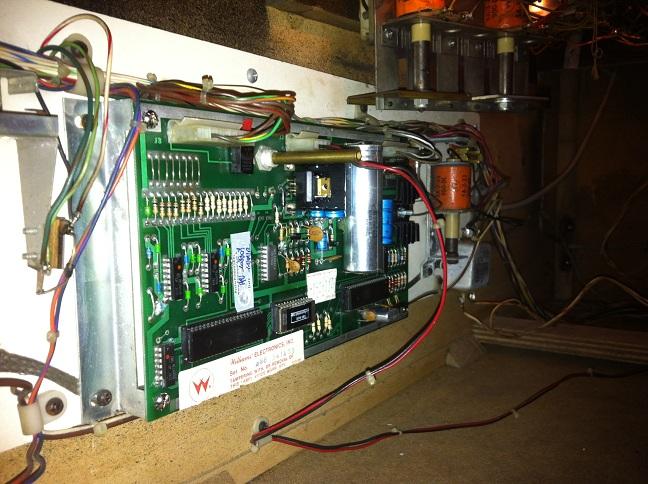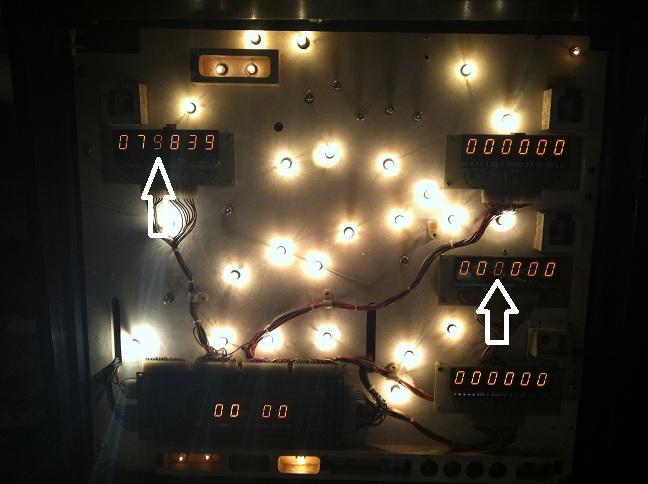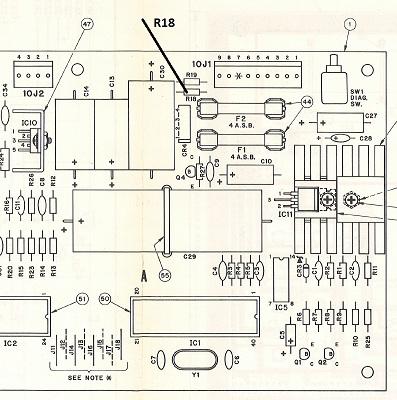FlipperFrance
Quoi! Comment! Pas encore membre d'FF ! Franchissez le pas, incrscrivez vous avec le mail de votre F.A.I (VPN Exclus) et participez à la vie flippéristique
Vous utilisez un navigateur non à jour ou ancien. Il ne peut pas afficher ce site ou d'autres sites correctement.
Vous devez le mettre à jour ou utiliser un navigateur alternatif.
Vous devez le mettre à jour ou utiliser un navigateur alternatif.
Restauration d'un Flash
- Auteur de la discussion Firepawa
- Date de début
Je viens de recevoir la carte son, voilà le résultat de mes premiers tests.
- Je commence par un test simple: une partie. tout marche pendant quelques secondes (tous les sons sont là) et puis plus rien...
- J'appuie sur le bouton Diagnostic et la carte joue un son en boucle.
- Je redémarre et pareil, le son fonctionne bien pendant quelques secondes puis plus rien. Le bouton 'Diagnostic' marche.
Premier réflexe: dégrippant contact sur le connecteur de contrôle (10J3) et sur la driver (2J9) mais rien ne change.
Bon à partir de là il faut déterminer d'où vient le problème, Carte son ou driver.
Je débranche le connecteur 10J3, j'allume l'appareil, et je test les pins de 10J3 (2,3,4,5,7) un à un en les mettant à la terre.
Résultat: pareil que pendant le jeu. Les sons sont joués un à un pour chaque pin mise à la terre puis après quelques tests plus rien quelque soit la pin.
A ce niveau il ne reste que 2 coupables potentiels: La carte son ou la carte d'alimentation.
Les tensions mesuré entre la terre et les pins de 10J1 (alim carte son):
1- 9.16 VAC
5- 0 VAC
9- 9.16 VAC
Est-ce que ces valeurs sont correctes ? La doc annonce 18.7VAC...
Que puis-je faire de plus pour avancer dans le diagnostique ? Merci.
La carte son en place:

- Je commence par un test simple: une partie. tout marche pendant quelques secondes (tous les sons sont là) et puis plus rien...
- J'appuie sur le bouton Diagnostic et la carte joue un son en boucle.
- Je redémarre et pareil, le son fonctionne bien pendant quelques secondes puis plus rien. Le bouton 'Diagnostic' marche.
Premier réflexe: dégrippant contact sur le connecteur de contrôle (10J3) et sur la driver (2J9) mais rien ne change.
Bon à partir de là il faut déterminer d'où vient le problème, Carte son ou driver.
Je débranche le connecteur 10J3, j'allume l'appareil, et je test les pins de 10J3 (2,3,4,5,7) un à un en les mettant à la terre.
Résultat: pareil que pendant le jeu. Les sons sont joués un à un pour chaque pin mise à la terre puis après quelques tests plus rien quelque soit la pin.
A ce niveau il ne reste que 2 coupables potentiels: La carte son ou la carte d'alimentation.
Les tensions mesuré entre la terre et les pins de 10J1 (alim carte son):
1- 9.16 VAC
5- 0 VAC
9- 9.16 VAC
Est-ce que ces valeurs sont correctes ? La doc annonce 18.7VAC...
Que puis-je faire de plus pour avancer dans le diagnostique ? Merci.
La carte son en place:
Bon alors en attendant de régler cette histoire de carte son, je m'intéresse à d'autres problèmes mineurs.
Par exemple j'ai deux digits sur deux afficheurs différents qui sont un peu faiblards:

Est-ce un signe que ça va bientôt lâcher ? J'ai testé avec d'autres afficheurs (j'en ai quelques-uns de rechange) mais toujours pareil sur les mêmes digits. Donc ça doit probablement venir de la Master Display. De plus ils sont faiblards à l'allumage puis ça se calme sans jamais redevenir aussi brillant que les autres.
Par exemple j'ai deux digits sur deux afficheurs différents qui sont un peu faiblards:
Est-ce un signe que ça va bientôt lâcher ? J'ai testé avec d'autres afficheurs (j'en ai quelques-uns de rechange) mais toujours pareil sur les mêmes digits. Donc ça doit probablement venir de la Master Display. De plus ils sont faiblards à l'allumage puis ça se calme sans jamais redevenir aussi brillant que les autres.
bon côté connectique j'ai tout passé au nettoyant contacts (displays et nappes). J'ai aussi relevé les cosses afin qu'elles appuient plus sur contacts des cartes. Malgré tout ça rien ne change, ni en bien ni en mal. J'en déduis que le problème ne vient pas de là.
Sinon je ne peux m’empêcher de remarquer sur les 2 digits faiblards sont sur les displays 1 et 3 et que c'est dans les deux cas le même digit (les 1000). Du coup je me dis qu'il faut que je trouve un composant qui sert à l'allumage de ces deux digits (s'il existe).
Je compulse les docs techniques du Master Display et je remarque un truc:

Player 1 et Player 3 partage la ligne 3 de STROBE. Je ne sais pas encore ce que c'est que ce STROBE mais j'imagine une pulsation électrique qui active le gaz des afficheurs (warning gros débutant qui réfléchit !). Bref en regardant le diagramme de la Master Display je vois que la ligne 3 de STROBE arrive par le connecteur 4J5 puis passe dans IC2 (un des 3 MC14069 HEX. INVERTER). Après IC2 le STROBE 3 part dans IC11 et IC12 puis direction les afficheurs. Le seul élément commun semble être IC2. Le problème pourrait-il venir de là ? J'écarte pour l'instant la carte CPU parce que je n'avais pas ce problème avec cette même CPU et les Display de mon Firepower.
Sinon je ne peux m’empêcher de remarquer sur les 2 digits faiblards sont sur les displays 1 et 3 et que c'est dans les deux cas le même digit (les 1000). Du coup je me dis qu'il faut que je trouve un composant qui sert à l'allumage de ces deux digits (s'il existe).
Je compulse les docs techniques du Master Display et je remarque un truc:

Player 1 et Player 3 partage la ligne 3 de STROBE. Je ne sais pas encore ce que c'est que ce STROBE mais j'imagine une pulsation électrique qui active le gaz des afficheurs (warning gros débutant qui réfléchit !). Bref en regardant le diagramme de la Master Display je vois que la ligne 3 de STROBE arrive par le connecteur 4J5 puis passe dans IC2 (un des 3 MC14069 HEX. INVERTER). Après IC2 le STROBE 3 part dans IC11 et IC12 puis direction les afficheurs. Le seul élément commun semble être IC2. Le problème pourrait-il venir de là ? J'écarte pour l'instant la carte CPU parce que je n'avais pas ce problème avec cette même CPU et les Display de mon Firepower.
Bon d'après ce que je comprends de mes docs récupérées sur www.firepowerpinball.com

UDN-6164 GAS DISCHARGE DISPLAY SEGMENT DRIVER (IC4, IC11, IC12, IC13)
IC4 - Master Diplay
IC11 - Player 1-2
IC12 - Player 2-3
IC13 - Player 3-4
Si le problème se situe ici il faut que IC11 et IC12 soient défectueux en même temps sur le même digit.
UDN-7180 GAS DISCHARGE DISPLAY SEGMENT DRIVER (IC9, IC10)
IC9 - Player 1-2
IC10 - Player 2-3
Si le problème se situe ici il faut que IC9 et IC10 soient défectueux en même temps sur le même digit.
MC14069 HEX. INVERTER (IC1, IC2, IC3)
IC1 - Master Display
IC2 - Player 1-3
IC3 - Player 2-4
Si le problème se situe ici il suffit que IC2 soit defecteux sur la ligne 3 pour affecter les afficheurs 1 et 3 sur la digit des 1000s.
- N'est-il pas plus logique de suspecter le MC14069 plutôt que les UDN ?
- Est-ce que UDN6118 remplace tous les UDN spécifiés plus haut ? Je te prendrais bien des UDN6118 mais je m'y perds dans toutes ces références...
- As-tu un remplacent pour le MC14069 ? Je n'ai pas trouvé mais encore une fois je m'y perds un peu la dedans
merci

UDN-6164 GAS DISCHARGE DISPLAY SEGMENT DRIVER (IC4, IC11, IC12, IC13)
IC4 - Master Diplay
IC11 - Player 1-2
IC12 - Player 2-3
IC13 - Player 3-4
Si le problème se situe ici il faut que IC11 et IC12 soient défectueux en même temps sur le même digit.
UDN-7180 GAS DISCHARGE DISPLAY SEGMENT DRIVER (IC9, IC10)
IC9 - Player 1-2
IC10 - Player 2-3
Si le problème se situe ici il faut que IC9 et IC10 soient défectueux en même temps sur le même digit.
MC14069 HEX. INVERTER (IC1, IC2, IC3)
IC1 - Master Display
IC2 - Player 1-3
IC3 - Player 2-4
Si le problème se situe ici il suffit que IC2 soit defecteux sur la ligne 3 pour affecter les afficheurs 1 et 3 sur la digit des 1000s.
- N'est-il pas plus logique de suspecter le MC14069 plutôt que les UDN ?
- Est-ce que UDN6118 remplace tous les UDN spécifiés plus haut ? Je te prendrais bien des UDN6118 mais je m'y perds dans toutes ces références...
- As-tu un remplacent pour le MC14069 ? Je n'ai pas trouvé mais encore une fois je m'y perds un peu la dedans
merci
j'ai fait quelques mesures sur les MC14069 HEX. INVERTER (IC1, IC2, IC3)
4.5VDC sur les entrées
0.3VDC sur les sorties
Sauf sur la ligne 3 qui correspond à mes digits faiblards
4.5VDC en entrée
0.04VDC en sortie
Je ne sais pas si on peut faire une mesure sérieuse sur ces IC mais en tout cas j'ai un résultat constant sur toutes les lignes de STROBE sauf sur celle qui correspond à mes digits faiblards.
Coïncidence troublante...
4.5VDC sur les entrées
0.3VDC sur les sorties
Sauf sur la ligne 3 qui correspond à mes digits faiblards
4.5VDC en entrée
0.04VDC en sortie
Je ne sais pas si on peut faire une mesure sérieuse sur ces IC mais en tout cas j'ai un résultat constant sur toutes les lignes de STROBE sauf sur celle qui correspond à mes digits faiblards.
Coïncidence troublante...
Tu ne peux pas mesurer la tension
Car c'est multiplexé
Il faut voir les signaux à l'oscillo
Je ne dis pas que les CMOS ne seraient pas en faute, mais le plus classique sera l'UDN
Dans le texte je lis une énormité
Il faut des DISPLAY DIGIT driver et des DISPLAY SEGMENT driver .....
Là j'en lis deux pour la même action
Car c'est multiplexé
Il faut voir les signaux à l'oscillo
Je ne dis pas que les CMOS ne seraient pas en faute, mais le plus classique sera l'UDN
Dans le texte je lis une énormité
Il faut des DISPLAY DIGIT driver et des DISPLAY SEGMENT driver .....
Là j'en lis deux pour la même action
merci de me corriger en effet les IC11, IC12 et IC13 sont des GAS DISCHARGE DISPLAY DIGIT DRIVER. Ils sont bien indiqués sur le schéma, j'ai mal recopié (dommage qu'on ne puisse pas éditer ses messages).
Je comprends que les UDN sont souvent un problème et c'est pour ça que j'en veux quelques pièces.
Par contre avant de commander j'aimerai savoir si les UDN6118 que tu vends remplacent toutes les références d'UDN et si tu as aussi un remplacent pour les MC14069.
Je comprends que les UDN sont souvent un problème et c'est pour ça que j'en veux quelques pièces.
Par contre avant de commander j'aimerai savoir si les UDN6118 que tu vends remplacent toutes les références d'UDN et si tu as aussi un remplacent pour les MC14069.
Ça y est j'ai reçu la carte son numéro 2. Cette fois-ci c'est le même modèle que l'original (2 fusibles) contrairement à la précédente (1 fusible). Ca reste des carte son type 1 dans les deux cas.
La carte fonctionne parfaitement. Aaaah les bons vieux sons des années 80 inimitable
Le seul inconvénient c'est le huuum qu'elle émet en permanence. Ça ne gène pas pendant le jeux mais pendant le game over mon côté perfectionniste se dit qu'il faudrait améliorer ça. La carte d'origine le faisait, la première carte de RP ne le faisait pas, et celle-là le fait de nouveau.
Il semblerait que ça soit une problème connu sur cette génération de carte son. Voilà ce qu'en dit le si tu as la bible Marre Vinne, aide toi et le ciel t'aidera alors:

La carte fonctionne parfaitement. Aaaah les bons vieux sons des années 80 inimitable

Le seul inconvénient c'est le huuum qu'elle émet en permanence. Ça ne gène pas pendant le jeux mais pendant le game over mon côté perfectionniste se dit qu'il faudrait améliorer ça. La carte d'origine le faisait, la première carte de RP ne le faisait pas, et celle-là le fait de nouveau.
Il semblerait que ça soit une problème connu sur cette génération de carte son. Voilà ce qu'en dit le si tu as la bible Marre Vinne, aide toi et le ciel t'aidera alors:
La suggestion est de remplacer R18 d'une 220 Ohms en 100 Ohms. David qu'en penses-tu ?Reducing Hum on Type1 System3/4 Sound Boards.
As documented by G.Sylvain. Early type 1 sound board games can have noticeable hum in the speaker, especially bothersome during game-over mode. The hum would not be affected by the position of the volume control on neither the cabinet nor on the sound board itself.
I made sure all screws on all boards were present and tight, along with clean brackets, to ensure a good ground connection. That did not help. The second and most obvious problem are old electrolytic capacitors on the sound board, mainly C10, C30 and C29. These were replaced with new ones to no avail. I even replaced the amp's feedback capacitor C13, and again no help.
I noticed that the hum would be greatly lowered if I reduced the type1 sound board resistor R18 from 220 ohms to 100 ohms. This resistor controls negative feedback to the TDA 2002 audio amplifier, thus the overall gain/volume. On more modern Williams sound boards with speech such as Black Knight, the hum is almost zero, while the final audio amplifier circuitry is essentially the same (except for one additional 1K resistor and a different cap value).
Changing R18 to 100 ohms will reduce the maximum audio volume of the game, and the volume must be turned up. I felt that the maximum sound level was still powerful enough for most home-use applications. Besides, it lowered the hum enough to make this 'work-around' fix quite acceptable.

Cette résistance là fait office de gain pour le TDA2002
Non le HUM peut venir de ta masse dans le jeu
Tout le jeu en charge lui même
Elle a déjà le correctif au niveau des résistances de 10 K Ohm
Mais cela n'affecte en rien le fonctionnement
Essaye mais je suis pas certain que cela change tout
Non le HUM peut venir de ta masse dans le jeu
Tout le jeu en charge lui même
Elle a déjà le correctif au niveau des résistances de 10 K Ohm
Mais cela n'affecte en rien le fonctionnement
Essaye mais je suis pas certain que cela change tout
J'ai changé R18 par une résistance de 100 ohms. Le HUM est beaucoup mois présent. Maintenant ça ressemble à un transformateur un peu bruyant, c'est supportable.
J'ai aussi testé la masse entre une patte d'une résistance sur le carte (R19) et un peu partout dans la caisse, le haut-parleur, la backbox... ça passe nickel de partout.
Pour moi c'est satisfaisant, surtout que ça semble être un problème de la génération. D'autres avis ? Personne avec un Flash ou un flip de la même génération qui lit ces lignes ?
J'ai aussi testé la masse entre une patte d'une résistance sur le carte (R19) et un peu partout dans la caisse, le haut-parleur, la backbox... ça passe nickel de partout.
Pour moi c'est satisfaisant, surtout que ça semble être un problème de la génération. D'autres avis ? Personne avec un Flash ou un flip de la même génération qui lit ces lignes ?
Installez l'appli
Comment installer l'application sur iOS
Suivez la vidéo ci-dessous pour voir comment installer notre site en tant qu'application Web sur votre écran d'accueil.
Note: Cette fonctionnalité peut ne pas être disponible dans certains navigateurs.
